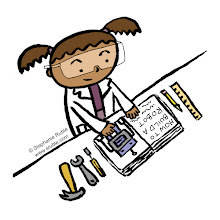I thought I'd share five things that helped me to push my art to the next level, and will hopefully help you too:
1. Take
writing classes/workshops/conference sessions. Think of the characters
you draw in the same way that writers are taught to think about the
characters they write. What are your characters strengths, weaknesses,
wants, friends, enemies, favorite things, emotional reactions, family,
etc.? Use those things (a.k.a. who your character is) when you draw
your story (how your character looks, where they live, and who they
interact with).
2. Read current books like the ones you want to
illustrate (PBs, MGs, etc.). Pay attention to which illustrators you
love/hate. Try to figure out why you love/hate them, and how you can
make your work stand out like they do (by being inspired by them, but
not copying them).
For instance, if you love the emotion and
facial expressions someone does, look at your own characters. Do they
show enough emotion? If not, how can you amp that up in your work?
Another
example: if you like the character design, what makes an illustrator's
character design stand out to you? Is it the shapes? Hard/soft edges?
Exaggerated features? Compare what you like about their character design
to what you're doing. Can you push your art further to make your
character design stand out in a similar or opposite way?
Read the
words and see how the illustrator translated that into the art. How
would you do it? The same? Different? Then look at your art and think
about the story you're trying to tell. Do you mirror the words? Extend
the story? What would make it even better? If you can't think of
anything, consider asking for help from an illustrator friend, critique
group, or a critique at a conference.
One artist I've looked at
over the years is Tuesday Mourning (and not just because of her name,
though I do like it). Her drawings of Princess Peepers by Pam Calvert were really interesting to me. I loved her art
when she was only illustrating novels, and then loved her picture book
art too! I was inspired seeing the similarities/differences in her art
for different age groups. It was also fun and informative to see how she
extended Pam's story in her drawings. (You can learn a lot by studying
how another illustrator chooses to picture a story, and thinking about
how you'd do it differently, or if you would keep their art and wouldn't
change a thing.)
3. What area of your art do you need to work
on? (If you're not sure, what do critiquers say you need to work on?)
Design a project that helps you to achieve that goal.
One thing I
did that helped immensely: I worked to figure out what publishers
wanted, what I was good at, and what made good picture book art (because
picture book art is different than other types of illustration and fine
art). I also made my own art projects, including one that ended up
taking two years (I drew and/or painted a cow a day for a year, then dog
a day for a second year). I did that to help hone my skills after
coming from an abstract art background. I needed to do it to start
thinking about illustration rather than fine art paintings. It still
took several years after that before I got a book deal, but if I hadn't
taken the time to grow my art, I'm pretty sure I still wouldn't have a
book deal.
4. Take time for personal art that you make just for
fun (could be five minutes a day, a week long painting, or a craft
project - whatever is fun for you). Every time I do this, from the daily
drawing projects to painting, crafts, etc. my art has grown in leaps
and bounds, and I've gotten ideas and inspiration for stories and
portfolio art. One of my goals for next year is to try to squeeze in
more time for personal art.
5. Have a website or blog, or
somewhere online where a publisher can find your art. If they can't find
you, they can't contact you about a project that could be right for
you.
If you're
interested in becoming a picture book illustrator and/or writer, here are some of my past posts that might help:
The Path Illustrators Take To Get Their Work Noticed And Advance Their Careers
The Importance Of Making Art For Fun
Three Ways To Make A Picture Book Dummy
Ten Tips For Choosing What To Draw For Your Portfolio, And Ten Ways To Find Inspiration
How To Write A Picture Book In Twelve Easy Steps
If You Just Want To Illustrate And Not Write

